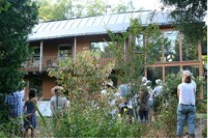Solar energy put to work on Hart County farms

“If anyone tells you solar energy doesn’t work in Kentucky, they are wrong. It’s all about a balance of what you use and what you produce,” says Sam Avery.
And he has the proof. His farmhouse in Upton, Kentucky touts several solar features, including a water heater, thermal heating system and rooftop photovoltaic panels.
Built in 1978
Insulation layer outside of stone walls creates a thermal wrap
Large windowed front foyer is heated by passive solar and provides an energy efficient air buffer
Solar thermal collector provides ½ the home's heat and heats a below-ground greenhouse
Has solar hot water heater
Rooftop solar panels produce 16 kilowatt hours per day at peak (more than the home uses)
Electricity-free hydraulic pump sends 10 gallons of water per hour to the house from the nearby stream
Sam and his wife, Bonnie, built the house in 1978, shortly after purchasing the tract of land in Hart County. Along with a couple dozen friends, they did so as a part of the “back to the land” movement. Sam incorporated passive and active solar into the design of the home from the start.
“These things just seemed common sense to me when I built the house,” Sam said to a crowd of 35 that gathered at his farmhouse on Friday, July 6. A mix of KFTC members and new friends toured the farm to learn about how each of the home’s renewable energy systems works.
Several people climbed up on the roof to see the solar panels and the large tank in the attic peak that holds the home’s hot water. Another group walked down the hill to understand how the electric-free hydraulic pump that brings water up the hill from a nearby stream works.
Through his business Avery and Sun, Sam, a trained installer, has put solar systems on other homes in the area as well. Two years ago, he installed a system on the home of fellow KFTC members and neighbors Wendy and Dennis Price that produces as much electricity as they use.
 Wendy likes how easily the solar panels replaced their reliance on coal-burning grid-based electricity. “You don’t notice anything different at all, except a few clicks at dawn and dusk when the system comes on and turns off,” she said.
Wendy likes how easily the solar panels replaced their reliance on coal-burning grid-based electricity. “You don’t notice anything different at all, except a few clicks at dawn and dusk when the system comes on and turns off,” she said.
Everyone at the party was a customer of EKPC’s rural electric cooperatives – living in either the Nolin RECC or Farmers RECC district. As a result, the group was particularly interested to learn about KFTC’s efforts to Renew East Kentucky, a campaign to shift the rural electric co-ops toward a culture of energy efficiency and renewable energy.
Sam noted that getting involved in reforming local electric co-ops is a good place to start advocating for clean energy. “As you know, the co-ops are in fact democratic. But as long as the lights go on, most people don’t think about the fact that we are owners of them,” Sam said.
The Averys also encouraged people to understand more about the source of their electricity by going on a mountain witness tour in eastern Kentucky and to lobby their legislators for better state clean energy policy.

As a member of KFTC’s New Energy and Transition committee and having joined the Kentucky Sustainable Energy Alliance as a business member, Sam has been particularly active in advocating for the Clean Energy Opportunity Act, a bill in the Kentucky legislature that would establish a renewable and efficiency portfolio standard and feed-in tariffs for Kentucky.
Sam described himself to the crowd as someone who is not a “joiner.” But he said he continues to be a member of and donate volunteer time to KFTC because he believes it will work.
“It takes people organized, people writing letters, it takes time. We’ll have progressive energy legislation in this state – we will have it.”
Recent News
Kentucky’s past legislative session showed alarming trend toward government secrecy
Churchill Downs takes more than it gives. That's why the Kentucky Derby is a no-go for me
‘We must never forget.’ Kentucky town installs markers for lynching victims.
Featured Posts
Protecting the Earth
TJC Rolling Out The Vote Tour – a KFTC Reflection Essay
KFTC Voter Empowerment Contractor Reflection Essay
Archives
- Home
- |
- Sitemap
- |
- Get Involved
- |
- Privacy Policy
- |
- Press
- |
- About
- |
- Bill Tracker
- |
- Contact
- |
- Links
- |
- RSS


Add new comment